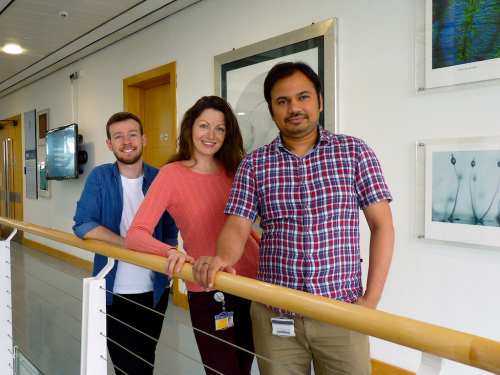
In 2004 mutations in a little studied kinase called PTEN-induced kinase 1 (PINK1) were identified in patients with early-onset Parkinson’s disease [1]. PINK1 is distinct from other protein kinases due to the presence of three loop insertions within its catalytic domain and a C-terminal region of unknown function. Significant progress has been made on the downstream functions of PINK1 including the discovery that PINK1 can phosphorylate both ubiquitin and the Parkin E3 ligase at a conserved Serine65 residue (Ser65) leading to Parkin activation. However, the mechanism by which PINK1 targets its substrates and how disease mutations affected this process was completely unknown.
Over 8 years ago the laboratories of Miratul Muqit and Daan van Aalten forged a collaboration to solve the structure of PINK1 in an attempt to understand its molecular regulation and the mechanism of disease associated mutations. Through a jointly supervised PhD student, Helen Woodroof, an initial breakthrough was made in the identification of constitutively active insect orthologues of PINK1 including Tribolium casataneum (TcPINK1) and Pediculus humanus corporis (PhcPINK1) [2]. Helen exploited this discovery to establish the first assays of PINK1 catalytic activity in the field [2]. Helen then focused on solving the structure of TcPINK1 and succeeded in obtaining the first crystals that diffracted to between 8-10 Angstroms. A joint post-doc, Jevgenia Tamjar, next took up the challenge and after several years managed to obtain crystals of TcPINK1 that diffracted to 3.35 Angstroms that were further improved by senior staff scientist, Olawale Raimi.
Finally, joint post-doc, Atul Kumar, eventually solved the TcPINK1 structure at ~2.8 Angstroms that has just been published in the journal eLife. Atul’s structure has revealed startling new insights into PINK1 including the discovery that the C-terminal region is not a distinct domain as previously thought but instead an ordered extension of the C-lobe that stabilizes catalytic residues. The structure also provides molecular insights into how approximately twenty disease associated mutations of PINK1 impact on the kinase.
Complementary biochemical analysis undertaken by PhD student, Andrew Waddell, has revealed that the third loop insertion forms a bowl-shaped binding site for ubiquitin. Mutation of the third loop prevents the ability of TcPINK1 to phosphorylate ubiquitin and Parkin but does not affect its trans(auto)phosphorylation activity. Furthermore, another PhD student, Andrew Shaw has confirmed that the third loop is also crucial for hPINK1 to phosphorylate ubiquitin and Parkin in cell based studies.
Overall the structure of TcPINK1 represents a key advance in understanding the mechanism of its regulation and will provide a framework for the exploration of small molecule modulators of PINK1.
Professor Dario Alessi, Director of the MRC PPU, commented, “I warmly congratulate Daan van Aalten and Miratul Muqit on solving the atomic structure of PINK1 which provides important new insights into understanding and better treating Parkinson’s disease. This is a wonderful achievement and has been a very difficult project that has taken over eight years of painstaking research. Many researchers would have given up long ago. This work illustrates the importance of persistence and collaboration that is required to solve the most important problems in medical research. Miratul was a key member of the team that discovered PINK1 in 2004 and has made many valuable contributions to our understanding of PINK1 in Parkinson’s disease.”
Michael Dunn, Head of Wellcome’s Genetics and Molecular Sciences team, said, “The PINK1 protein has been the focus of research all over the world, so this finding from the Dundee team is a fantastic step forward for the community. If we understand the structure of this protein, which holds so many clues into what goes wrong in Parkinson’s, it may help us develop novel drugs to protect against this devastating disease. Basic research is fundamental to understanding and treating many diseases and only by working in collaboration can we hope to make breakthroughs like this.”
Dr Nathan Richardson, MRC Head of Molecular and Cellular Medicine, said, “Discovering the fundamental structure of this protein is vital for understanding its cellular function and paves the way for the development of drugs to combat forms of early-onset Parkinson’s disease. This advance will also help reveal the molecular basis of genetic mutations in Parkinson’s disease, illustrating the merit of long term support for underpinning biomedical research."
Professor David Dexter, Deputy Director of Research at Parkinson’s UK, said, “The PINK1 gene was identified as a key player by Parkinson's UK-funded researchers back in 2004. Drugs that can switch the PINK1/parkin pathway back on may be able to slow, stop or even reverse nerve cell death, not only in people who have these rare inherited forms of the condition, but also those with non-inherited Parkinson's. This research, for the first time, gives us a view of what the PINK1 protein looks like and how changes in the gene can prevent the PINK1 protein working properly.“
The research was funded by the Wellcome Trust, Medical Research Council, Biotechnology and Biological Sciences Research Council, and Parkinson’s UK, including the Parkinson’s UK branches of Fife and Ayrshire.
To read a copy of the paper published in eLife click here.
References:
[1] Valente, E. M., Abou-Sleiman, P. M., Caputo, V., Muqit, M. M., Harvey, K., Gispert, S., Ali, Z., Del Turco, D., Bentivoglio, A. R., Healy, D. G., Albanese, A., Nussbaum, R., Gonzalez-Maldonado, R., Deller, T., Salvi, S., Cortelli, P., Gilks, W. P., Latchman, D. S., Harvey, R. J., Dallapiccola, B., Auburger, G. and Wood, N. W. (2004). Hereditary early-onset Parkinson's disease caused by mutations in PINK1. Science 304, pp. 1158-60
[2] Woodroof, H. I., Pogson, J. H., Begley, M., Cantley, L. C., Deak, M., Campbell, D. G., van Aalten, D. M., Whitworth, A. J., Alessi, D. R. and Muqit, M. M. (2011). Discovery of catalytically active orthologues of the Parkinson's disease kinase PINK1: analysis of substrate specificity and impact of mutations. Open Biol 1, pp. 110012

